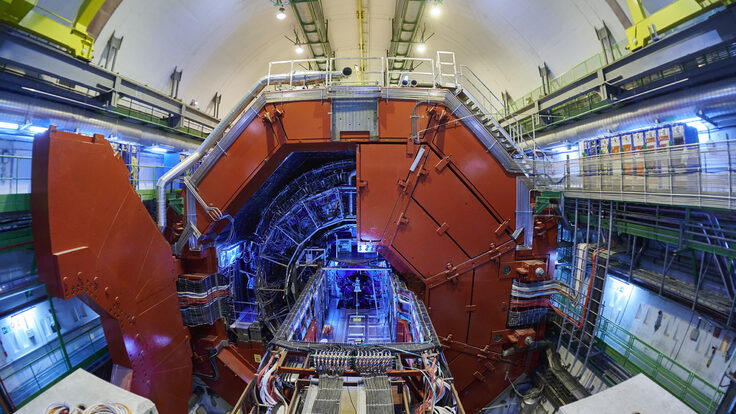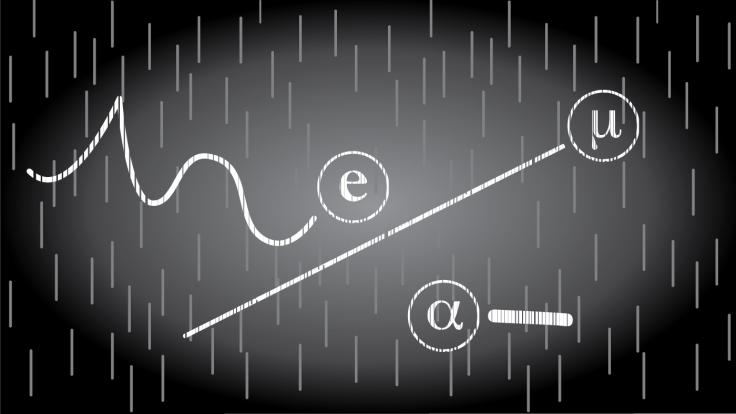Experiments at the Large Hadron Collider have begun to prove their worth among scientists who study the quark gluon plasma, a hot soup of unbound particles theorists say made up the universe just after the big bang.

The highest peak on the graph shows the production of tightly bound upsilons in both proton-proton and heavy-ion collisions. The bumps outlined in dotted blue show the production of the two other upsilon states in proton-proton collisions, while the red line shows the same production in heavy-ion collisions.
This week at Quark Matter 2011, scientists from LHC are sharing the results of their experiments, which have elevated studies of the QGP to a whole new energy level. Their observations of how particles react to the plasma have given them new hints as to its temperature and the strength of its influence.
“It’s a very exciting time,” said Brookhaven National Laboratory physicist Peter Steinberg of the ATLAS collaboration. “Now that we’ve all shown our hands, we’re going to start comparing results.”
Scientists from the CMS experiment gained new insights from the studies of particles called upsilons. An upsilon is a bound state of a bottom quark and its antiparticle. Upsilons come in three basic bound states, each almost identical to the next except for the strength of the bond between its quarks.
During most of the year, scientists at the LHC collide protons in their detectors. But for one month, they take a break from the usual fare to collide heavy ions. Heavy ion collisions have the ability to create quark gluon plasma.
Scientists on the CMS experiment at the LHC compared the production of the three states of upsilons in both types of collisions. Heavy-ion collisions seemed to produce a smaller fraction of lightly bound upsilons than proton-proton collisions. This could be because the less tightly bound upsilons break up in the heat of the quark gluon plasma, but not the most tightly bound ones.
The fact that only some types of upsilons melt apart in the QGP gives scientists a great tool for divining the temperature of the plasma. They can calculate the energies at which the different states would break apart. They know from experiment that the QGP is hotter than the breaking points of the weakest two states but cooler than that of the strongest one.
“Temperature is one of the most fundamental parameters,” said MIT scientist Bolek Wyslouch of the CMS collaboration. “Once you know that, you can look at other things.”
Scientists on the ALICE, ATLAS and CMS experiments have studied the interactions of other particles with the QGP. J/psi particles also seem to break up in the quark gluon plasma, but they only come in one easily measurable bound state. Photons and Z bosons do not interact strongly and so seem unaffected by the quark gluon plasma.
Another phenomenon scientists are using to reveal the secrets of the quark gluon plasma is jet quenching. Particle collisions often produce sprays of particles that fly away from the interaction point in opposite directions. Scientists looked that these back-to-back jets created in the quark gluon plasma and found that many of them were imbalanced. The jets on the side with a greater density of the plasma shrank significantly before shooting out the other side, apparently sapped of their energy by the QGP.
Scientists at Brookhaven National Laboratory previously studied jet quenching at the RHIC accelerator. This year, the ATLAS and CMS experiments were able to study jets in finer detail. This is because the particles in jets created in LHC collisions have greater energy and because the detectors at LHC experiments cover more area around the collision point than those at RHIC. The ALICE experiment will be able to do the same later this year, now that its new calorimeter is in place.
“LHC experiments have taken a giant step toward understanding the properties of the quark gluon plasma,” said Yale physicist John Harris of the ALICE experiment. “To me that just jumped out at the conference. We’ve made a quantum leap.”
Read the CERN press release.






